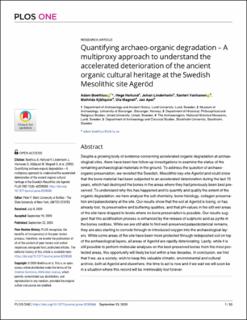| dc.contributor.author | Boethius, Adam | |
| dc.contributor.author | Hollund, Hege Ingjerd | |
| dc.contributor.author | Linderholm, Johan | |
| dc.contributor.author | Vanhanen, Santeri | |
| dc.contributor.author | Kjällquist, Mathilda | |
| dc.contributor.author | Magnell, Ola | |
| dc.contributor.author | Apel, Jan | |
| dc.coverage.spatial | Sweden, Ageröd | en_US |
| dc.date.accessioned | 2021-04-08T11:25:14Z | |
| dc.date.available | 2021-04-08T11:25:14Z | |
| dc.date.created | 2020-10-26T10:34:59Z | |
| dc.date.issued | 2020-09 | |
| dc.identifier.citation | Boethius A, Hollund H, Linderholm J, Vanhanen S, Kjällquist M, Magnell O, et al. (2020) Quantifying archaeo-organic degradation – A multiproxy approach to understand the accelerated deterioration of the ancient organic cultural heritage at the Swedish Mesolithic site Agero¨d. PLoS ONE 15(9): e0239588. | en_US |
| dc.identifier.issn | 1932-6203 | |
| dc.identifier.uri | https://hdl.handle.net/11250/2736874 | |
| dc.description.abstract | Despite a growing body of evidence concerning accelerated organic degradation at archaeological sites, there have been few follow-up investigations to examine the status of the remaining archaeological materials in the ground. To address the question of archaeo-organic preservation, we revisited the Swedish, Mesolithic key-site Ageröd and could show that the bone material had been subjected to an accelerated deterioration during the last 75 years, which had destroyed the bones in the areas where they had previously been best preserved. To understand why this has happened and to quantify and qualify the extent of the organic degradation, we here analyse the soil chemistry, bone histology, collagen preservation and palaeobotany at the site. Our results show that the soil at Ageröd is losing, or has already lost, its preservative and buffering qualities, and that pH-values in the still wet areas of the site have dropped to levels where no bone preservation is possible. Our results suggest that this acidification process is enhanced by the release of sulphuric acid as pyrite in the bones oxidizes. While we are still able to find well-preserved palaeobotanical remains, they are also starting to corrode through re-introduced oxygen into the archaeological layers. While some areas of the site have been more protected through redeposited soil on top of the archaeological layers, all areas of Ageröd are rapidly deteriorating. Lastly, while it is still possible to perform molecular analyses on the best-preserved bones from the most protected areas, this opportunity will likely be lost within a few decades. In conclusion, we find that if we, as a society, wish to keep this valuable climatic, environmental and cultural archive, both at Ageröd and elsewhere, the time to act is now and if we wait we will soon be in a situation where this record will be irretrievably lost forever. | en_US |
| dc.language.iso | eng | en_US |
| dc.publisher | Public Library of Science (PLoS) | en_US |
| dc.rights | Navngivelse 4.0 Internasjonal | * |
| dc.rights.uri | http://creativecommons.org/licenses/by/4.0/deed.no | * |
| dc.subject | arkeologi | en_US |
| dc.subject | bevaring av arkeologiske funn | en_US |
| dc.title | Quantifying archaeo-organic degradation – A multiproxy approach to understand the accelerated deterioration of the ancient organic cultural heritage at the Swedish Mesolithic site Ageröd | en_US |
| dc.type | Peer reviewed | en_US |
| dc.type | Journal article | en_US |
| dc.description.version | publishedVersion | en_US |
| dc.rights.holder | © 2020 Boethius et al. | en_US |
| dc.subject.nsi | VDP::Humaniora: 000::Arkeologi: 090::Nordisk arkeologi: 091 | en_US |
| dc.source.volume | 15 | en_US |
| dc.source.journal | PLOS ONE | en_US |
| dc.source.issue | 9 | en_US |
| dc.identifier.doi | 10.1371/journal.pone.0239588 | |
| dc.identifier.cristin | 1842189 | |
| cristin.ispublished | true | |
| cristin.fulltext | original | |
| cristin.qualitycode | 1 | |

